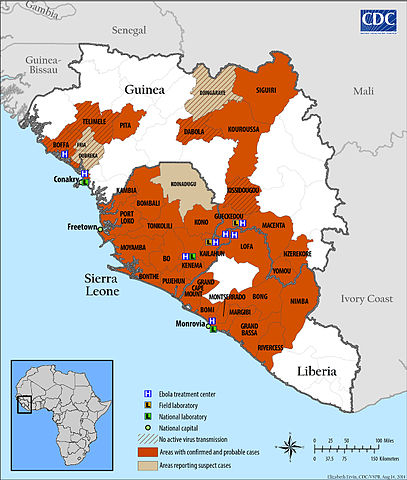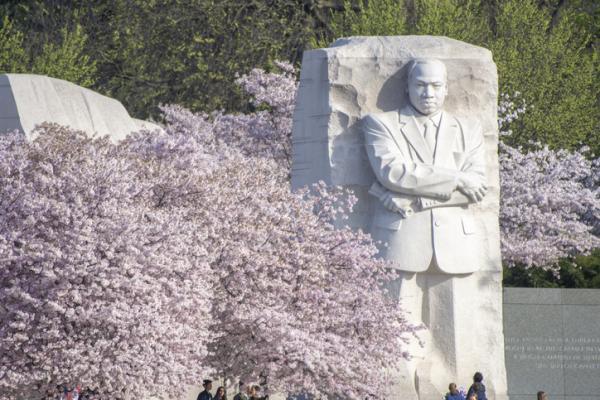Ebola Fact Sheet

Facts and stats about the virus
 2014 West Africa Ebola Virus Outbreak Map Related Links |
An outbreak of Ebola struck several countries in West Africa in May 2014. By the fall, it had become the worst single Ebola outbreak in history. It was also the deadliest. By Dec. 3, according to the World Health Organization (WHO), 6,070 people had died from the outbreak, including at least 150 doctors. The total number of cases had increased to 17,145, including the 6,070 deaths.
U.S. health officials have issued an advisory for Americans to avoid nonessential travel to Liberia, Guinea, and Sierra Leone because of the outbreak. The Centers for Disease Control and Prevention (CDC) has issued a level three warning, its most urgent travel notice, for Liberia, Guinea, and Sierra Leone. CDC has also issued a level two alert for Nigeria. Meanwhile, West African governments have been taking steps to fight the virus, such as deploying the army and police to conduct house-to-house searches.
Cases in U.S. and Spain
In Spain, Teresa Romero, a nursing assistant, became the first person known to contract the virus outside of Africa after being in contact with two missionaries who received treatment for Ebola at a hospital in Madrid. On Oct. 21, Romero was declared Ebola free.
On Sept. 30, a man who traveled from Liberia to Dallas, Tex., became the first case diagnosed in the United States. The man, later identified as Thomas Eric Duncan, died on Oct. 8, 2014. Four days later Nina Pham, a nurse who treated Duncan, became the first person to contract Ebola within the United States. Health officials began to investigate how she got the virus while wearing protective gear.
Another Dallas health care worker who treated Duncan was diagnosed with Ebola on Oct. 15. Nurse Amber Joy Vinson was isolated at Texas Health Presbyterian Hospital in Dallas a day after flying from Ohio to Texas. More than 70 hospital staffers who treated Duncan were monitored for symptoms. In addition, the CDC asked all 132 passengers who shared Frontier Airlines Flight 1143 with Vinson to call and be interviewed. By Oct. 20, most of the people who treated Duncan at the hospital in Dallas were no longer at risk of contracting the virus. Pham and Vinson were transferred to different U.S. hospitals for treatment.
Travel Restrictions Increase, First NYC Case
In mid-October, the CDC placed restrictions on travelers from Liberia, Guinea, and Sierra Leone. Travelers from those countries were required to report their morning and evening temperatures for three weeks to state or local health departments. The Obama administration announced that passengers from all countries affected by the virus must travel through one of five U.S. airports that were prepared to screen them for the disease: Kennedy International in New York, Newark Liberty International, Washington Dulles International, O'Hare International in Chicago, and Hartsfield-Jackson International in Atlanta. Obama also appointed political adviser Ron Klain to be the Ebola response coordinator in the United States.
On Oct. 23, Dr. Craig Spencer became the first person to test positive for the virus in New York City. Spencer had returned recently from Guinea where he volunteered with Doctors Without Borders to treat Ebola patients. He was placed in isolation at Bellevue Hospital Center. Spencer remained in stable condition while health officials retraced his steps and sought out everyone who had been in contact with him in the last three days. Meanwhile, Pham was declared free of Ebola and released from the hospital on Oct. 24. Four days later, Vinson was released after being declared free of the deadly virus. Dr. Spencer was declared virus free and released from Bellevue Hospital Center on Nov. 12.
Five days later, Dr. Martin Salia, who contracted Ebola while working in Sierra Leone, died at a Nebraska hospital where he was being treated for the virus. A native of Sierra Leone, Salia had been in critical condition when he arrived in the U.S., according to a news release by the Nebraska Medical Center. As of early Dec., at least 20 cases had been treated in the U.S. and Europe. Most were health workers who contracted the virus while working in West Africa.
What Is Ebola?
Known also as the Ebola virus disease, Ebola is a deadly, rare disease. It is caused by infection from one of four Ebola virus strains: Zaire, Sudan, Bundibugyo, or Tai Forest virus. First discovered in 1976, Ebola outbreaks have occurred sporadically in several African countries ever since.
Symptoms
Symptoms include severe headaches, muscle aches, vomiting, diarrhea, stomach aches, unexplained bleeding or bruising, and a fever of greater than 38.6°C or 101.5°F. Symptoms usually appear eight to ten days after exposure to the virus.
How Ebola Spreads
The Ebola virus is spread by direct contact with bodily fluids (feces, saliva, semen, urine, vomit) of an infected person. It can also be spread by the use of objects such as needles that have been contaminated with the virus. Ebola is not spread by water or air. Typically, it is not spread by food, although Ebola can spread as a result of handling wild animals hunted down for food. Finally, it can be spread by contact with infected bats.
Countries Affected
The affected countries are Guinea, Liberia, Mali, Nigeria, Senegal, Sierra Leone, Spain, and the United States of America. The CDC, WHO, and others are working together to respond to the virus. The Emergency Operations Center has been activated by CDC to oversee activities and offer technical support. CDC has also deployed several public health experts to the affected region.
It appears that the virus has not been widely spread. In Nigeria, the small number of cases has been linked to an infected man who traveled there from Liberia. On Oct. 23, Mali confirmed one case. By late October, the WHO declared that the epidemic was over in Senegal and Nigeria.
Guinea
- 2,164 cases have been reported, including 1,327 deaths.
- The districts affected are: Conakry, Gueckedou, Macenta, Kissidougou, Dabola, Djingaraye, Telimele, Boffa, Kouroussa, Dubreka, Fria, Siguiri, Pita, Nzerekore, and Yamou.
Liberia
- 7,635 cases have been reported, including 3,145 deaths.
- Cases are suspected or confirmed in 13 out of Liberia's 15 counties.
- Lab testing is being conducted in Monrovia, the capital.
Nigeria
- 20 cases were reported, including eight deaths. By late October, the epidemic was declared over in Nigeria.
Sierra Leone
- 7,312 cases have been reported, including 1,583 deaths.
- 11 out of Sierra Leone's 12 districts have had cases confirmed.
Treatment
Thus far, no medicine or vaccine has been able to cure Ebola. Symptoms are treated as they occur. These basic interventions can increase survival chances if applied early.
- Fluids and electrolytes
- Maintaining oxygen flow and blood pressure levels
- Receiving treatment for other infections as they appear
Prevention
If traveling to an Ebola outbreak area, do the following to help with prevention.
- Frequently wash your hands.
- Avoid contact with bodily fluids of any person, especially if they are sick.
- Seek immediate medical care if you develop a fever or any of the symptoms mentioned above.
- Don't touch bats.
- Don't touch nonhuman primates or their blood or fluids.
- Don't touch or eat raw meat.
- Avoid hospitals where Ebola patients are being treated.
- Don't touch the body of someone who has died from Ebola.
Source: World Health Organization, Centers for Disease Control and Prevention
—Jennie Wood







